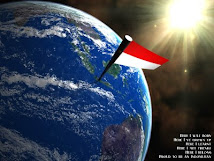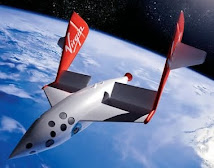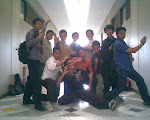
By:
Arip Nurahman
Department of Physics
Faculty of Sciences and Mathematics, Indonesia University of Education
and
Follower Open Course Ware at Massachusetts Institute of Technology
Cambridge, USA
Department of Physics
http://web.mit.edu/physics/
http://ocw.mit.edu/OcwWeb/Physics/index.htm
&
Aeronautics and Astronautics Engineering
http://web.mit.edu/aeroastro/www/
http://ocw.mit.edu/OcwWeb/Aeronautics-and-Astronautics/index.htm


A
theory of everything (
TOE) is a putative
theory of
theoretical physics that fully explains and links together all known physical phenomena. Initially, the term was used with an ironic connotation to refer to various overgeneralized theories. For example, a great-grandfather of
Ijon Tichy — a character from a cycle of
Stanisław Lem's
science fiction stories of 1960s — was known to work on the "General Theory of Everything". Physicist
John Ellis claims
[1] to have introduced the term into the technical literature in an article in
Nature in 1986.
[2] Over time, the term stuck in popularizations of
quantum physics to describe a theory that would unify or explain through a single model the theories of all
fundamental interactions of nature.
There have been many theories of everything proposed by theoretical physicists over the last century, but none have been confirmed experimentally. The primary problem in producing a TOE is that the accepted theories of
quantum mechanics and
general relativity are hard to combine.
Based on theoretical
holographic principle arguments from the 1990s, many physicists believe that 11-dimensional
M-theory, which is described in many sectors by
matrix string theory, in many other sectors by
perturbative string theory is the complete theory of everything, although there is no widespread consensus.
Contents
Historical antecedents
Laplace famously suggested that a sufficiently powerful intellect could, if it knew the velocity of every particle at a given time, along with the laws of nature, calculate the position of any particle at any other time:
An intellect which at a certain moment would know all forces that set nature in motion, and all positions of all items of which nature is composed, if this intellect were also vast enough to submit these data to analysis, it would embrace in a single formula the movements of the greatest bodies of the universe and those of the tiniest atom; for such an intellect nothing would be uncertain and the future just like the past would be present before its eyes.
– Essai philosophique sur les probabilités, Introduction. 1814
Although modern
quantum mechanics suggests that uncertainty is inescapable, a "single formula" may nevertheless exist.
Ancient Greece to Einstein
Since
ancient Greek times,
philosophers have speculated that the apparent diversity of appearances conceals an underlying unity, and thus that the list of forces might be short, indeed might contain only a single entry. For example, the
mechanical philosophy of the 17th century posited that all forces could be ultimately reduced to
contact forces between tiny solid particles.
[3] This was abandoned after the acceptance of
Isaac Newton's long-distance force of gravity; but at the same time, Newton's work in his
Principia provided the first dramatic empirical evidence for the unification of apparently distinct forces:
Galileo's work on terrestrial gravity,
Kepler's laws of planetary motion, and the phenomonenon of
tides were all quantitatively explained by a single law of
universal gravitation.
In 1820,
Hans Christian Ørsted discovered a connection between electricity and magnetism, triggering decades of work that culminated in
James Clerk Maxwell's theory of
electromagnetism. Also during the 19th and early 20th centuries, it gradually became apparent that many common examples of forces—contact forces,
elasticity,
viscosity,
friction,
pressure—resulted from electrical interactions between the smallest particles of matter. In the late 1920s, the new quantum mechanics showed that the
chemical bonds between
atoms were examples of (quantum) electrical forces, justifying
Dirac's boast that "the underlying physical laws necessary for the mathematical theory of a large part of physics and the whole of chemistry are thus completely known".
[4]
Attempts to unify
gravity with electromagnetism date back at least to
Michael Faraday's experiments of 1849–50.
[5] After
Albert Einstein's theory of gravity (
general relativity) was published in 1915, the search for a
unified field theory combining gravity with electromagnetism began in earnest. At the time, it seemed plausible that no other fundamental forces exist. Prominent contributors were
Gunnar Nordström,
Hermann Weyl,
Arthur Eddington,
Theodor Kaluza,
Oskar Klein, and most notably, many attempts by Einstein and his collaborators. In his last years, Albert Einstein was intensely occupied in finding such a unifying theory. None of these attempts were successful.
[6]
New discoveries
The search for a unifying theory was interrupted by the discovery of the
strong and
weak nuclear forces, which could not be subsumed into either gravity or electromagnetism. A further hurdle was the acceptance that quantum mechanics had to be incorporated from the start, rather than emerging as a consequence of a deterministic unified theory, as Einstein had hoped. Gravity and electromagnetism could always peacefully coexist as entries in a list of Newtonian forces, but for many years it seemed that gravity could not even be incorporated into the quantum framework, let alone unified with the other fundamental forces. For this reason, work on unification for much of the twentieth century, focused on understanding the three "quantum" forces: electromagnetism and the weak and strong forces. The first two were
unified in 1967–68 by
Sheldon Glashow,
Steven Weinberg, and
Abdus Salam as the "electroweak" force.
[7] However, while the strong and electroweak forces peacefully coexist in the
standard model of particle physics, they remain distinct. Several
Grand Unified Theories (GUTs) have been proposed to unify them. Although the simplest GUTs have been experimentally ruled out, the general idea, especially when linked with
supersymmetry, remains strongly favored by the theoretical physics community.

Modern Physics
Electroweak unification is a
broken symmetry: the electromagnetic and weak forces appear distinct at low energies because the particles carrying the weak force, the
W and Z bosons have a mass of about 100 GeV, whereas the
photon, which carries the electromagnetic force, is massless. At higher energies Ws and Zs can be
created easily and the unified nature of the force becomes apparent. Grand unification is expected to work in a similar way, but at energies of the order of
1016 GeV, far greater than could be reached by any possible Earth-based
particle accelerator. By analogy, unification of the GUT force with gravity is expected at the
Planck energy, roughly
1019 GeV.
It may seem premature to be searching for a TOE when there is as yet no direct evidence for an electronuclear force, and while in any case there are many different proposed GUTs. In fact the name deliberately suggests the
hubris involved. Nevertheless, most physicists believe this unification is possible, partly due to the past history of convergence towards a single theory. Supersymmetric GUTs seem plausible not only for their theoretical "beauty", but because they naturally produce large quantities of dark matter, and the inflationary force may be related to GUT physics (although it does not seem to form an inevitable part of the theory). And yet GUTs are clearly not the final answer. Both the current standard model and proposed GUTs are
quantum field theories which require the problematic technique of
renormalization to yield sensible answers. This is usually regarded as a sign that these are only
effective field theories, omitting crucial phenomena relevant only at very high energies. Furthermore, the inconsistency between quantum mechanics and general relativity implies that one or both of these must be replaced by a theory incorporating
quantum gravity.
The mainstream theory of everything at the moment is
superstring theory /
M-theory; current research on
loop quantum gravity may eventually play a fundamental role in a TOE, but that is not its primary aim. These theories attempt to deal with the renormalization problem by setting up some lower bound on the length scales possible. String theories and
supergravity (both believed to be limiting cases of the yet-to-be-defined M-theory) suppose that the universe actually has more dimensions than the easily observed three of space and one of time. The motivation behind this approach began with the
Kaluza-Klein theory in which it was noted that applying general relativity to a five dimensional universe (with the usual four dimensions plus one small curled-up dimension) yields the equivalent of the usual general relativity in four dimensions together with
Maxwell's equations (electromagnetism, also in four dimensions). This has led to efforts to work with theories with large number of dimensions in the hopes that this would produce equations that are similar to known laws of physics. The notion of extra dimensions also helps to resolve the hierarchy problem, which is the question of why gravity is so much weaker than any other force. The common answer involves gravity leaking into the extra dimensions in ways that the other forces do not.
In the late 1990s, it was noted that one problem with several of the candidates for theories of everything (but particularly string theory) was that they did not constrain the characteristics of the predicted universe. For example, many theories of quantum gravity can create universes with arbitrary numbers of dimensions or with arbitrary
cosmological constants. Even the "standard" ten-dimensional string theory allows the "curled up" dimensions to be
compactified in an enormous number of different ways (one estimate is
10500) each of which corresponds to a different collection of fundamental particles and low-energy forces. This array of theories is known as the
string theory landscape.
A speculative solution is that many or all of these possibilities are realised in one or another of a huge number of universes, but that only a small number of them are habitable, and hence the fundamental constants of the universe are ultimately the result of the
anthropic principle rather than a consequence of the theory of everything. This anthropic approach is often criticised in that, because the theory is flexible enough to encompass almost any observation, it cannot make useful (as in original, falsifiable, and verifiable) predictions. In this view, string theory would be considered a
pseudoscience, where an unfalsifiable theory is constantly adapted to fit the experimental results.
With reference to Gödel's incompleteness theorem
A small number of scientists claim that
Gödel's incompleteness theorem proves that any attempt to construct a TOE is bound to fail. Gödel's theorem, informally stated, asserts that any sufficiently complex mathematical theory that has a finite description is either inconsistent or incomplete. In his 1966 book
The Relevance of Physics,
Stanley Jaki pointed out that, because any "theory of everything" will certainly be a consistent non-trivial mathematical theory, it must be incomplete. He claims that this dooms searches for a deterministic theory of everything.
[8]
| “ | Gödel’s theorem implies that pure mathematics is inexhaustible. No matter how many problems we solve, there will always be other problems that cannot be solved within the existing rules. [...] Because of Gödel's theorem, physics is inexhaustible too. The laws of physics are a finite set of rules, and include the rules for doing mathematics, so that Gödel's theorem applies to them. | ” |
Stephen Hawking was originally a believer in the Theory of Everything but, after considering Gödel's Theorem, concluded that one was not obtainable.
| “ | Some people will be very disappointed if there is not an ultimate theory, that can be formulated as a finite number of principles. I used to belong to that camp, but I have changed my mind. | ” |
This view has been argued against by
Jürgen Schmidhuber (1997), who pointed out that Gödel's theorems are irrelevant even for
computable physics.
[9] In 2000, Schmidhuber explicitly constructed limit-computable, deterministic universes whose
pseudo-randomness based on
undecidable, Gödel-like
halting problems is extremely hard to detect but does not at all prevent formal TOEs describable by very few bits of information.
[10][11]Related critique was offered by
Solomon Feferman,
[12] among others. Douglas S. Robertson offers
Conway's game of life as an example:
[13] The underlying rules are simple and complete, but there are formally undecidable questions about the game's behaviors. Analogously, it may (or may not) be possible to completely state the underlying rules of physics with a finite number of well-defined laws, but there is little doubt that there are questions about the behavior of physical systems which are formally undecidable on the basis of those underlying laws.
Since most physicists would consider the statement of the underlying rules to suffice as the definition of a "theory of everything", these researchers argue that Gödel's Theorem does
not mean that a TOE cannot exist. On the other hand, the physicists invoking Gödel's Theorem appear, at least in some cases, to be referring not to the underlying rules, but to the understandability of the behavior of all physical systems, as when Hawking mentions arranging blocks into rectangles, turning the computation of
prime numbers into a physical question.
[14] This definitional discrepancy may explain some of the disagreement among researchers.
Potential status of a theory of everything

No physical theory to date is believed to be precisely accurate. Instead, physics has proceeded by a series of "successive approximations" allowing more and more accurate predictions over a wider and wider range of phenomena. Some physicists believe that it is therefore a mistake to confuse theoretical models with the true nature of reality, and hold that the series of approximations will never terminate in the "truth". Einstein himself expressed this view on occasions.
[15] On this view, we may reasonably hope for
a theory of everything which self-consistently incorporates all currently known forces, but should not expect it to be the final answer. On the other hand it is often claimed that, despite the apparently ever-increasing complexity of the mathematics of each new theory, in a deep sense associated with their underlying
gauge symmetry and the number of
fundamental physical constants, the theories are becoming simpler. If so, the process of simplification cannot continue indefinitely.
There is a philosophical debate within the physics community as to whether a theory of everything deserves to be called
the fundamental law of the universe.
[16] One view is the hard
reductionist position that the TOE is the fundamental law and that all other theories that apply within the universe are a consequence of the TOE. Another view is that
emergent laws (called "free floating laws" by
Steven Weinberg), which govern the behavior of
complex systems, should be seen as equally fundamental. Examples are the
second law of thermodynamics and the theory of
natural selection. The point being that, although in our universe these laws describe systems whose behaviour could ("in principle") be predicted from a TOE, they would also hold in universes with different low-level laws, subject only to some very general conditions. Therefore it is of no help, even in principle, to invoke low-level laws when discussing the behavior of complex systems. Some argue that this attitude would violate
Occam's Razor if a completely valid TOE were formulated. It is not clear that there is any point at issue in these debates (e.g., between Steven Weinberg and
Philip Anderson) other than the right to apply the high-status word "fundamental" to their respective subjects of interest.
Although the name "theory of everything" suggests the determinism of Laplace's quote, this gives a very misleading impression. Determinism is frustrated by the probabilistic nature of quantum mechanical predictions, by the extreme sensitivity to initial conditions that leads to
mathematical chaos, and by the extreme mathematical difficulty of applying the theory. Thus, although the current standard model of particle physics "in principle" predicts all known non-gravitational phenomena, in practice only a few quantitative results have been derived from the full theory (e.g., the masses of some of the simplest
hadrons), and these results (especially the particle masses which are most relevant for low-energy physics) are less accurate than existing experimental measurements. The true TOE would almost certainly be even harder to apply. The main motive for seeking a TOE, apart from the pure intellectual satisfaction of completing a centuries-long quest, is that all prior successful unifications have predicted new phenomena, some of which (e.g.,
electrical generators) have proved of great practical importance. As in other cases of theory reduction, the TOE would also allow us to confidently define the domain of validity and residual error of low-energy approximations to the full theory which could be used for practical calculations.
Theory of everything and philosophy
The status of a physical TOE is open to
philosophical debate. For example, if
physicalism is true, a physical TOE would coincide with a philosophical theory of everything. Some philosophers (
Aristotle,
Plato,
Hegel,
Whitehead, et al) have attempted to construct all-encompassing systems. Others are highly dubious about the very possibility of such an exercise.
See also
References
- ^ Ellis, John (2002), "Physics gets physical (correspondence)", Nature 415: 957
- ^ Ellis, John (1986), "The superstring: theory of everything, or of nothing?", Nature 323: 595–598, doi:10.1038/323595a0
- ^ e.g., Shapin, Steven (1996). The Scientific Revolution. University of Chicago Press. ISBN 0226750213.
- ^ Dirac, P.A.M. (1929), "Quantum mechanics of many-electron systems", Proc. Royal Soc. London, Series A 123: 714, doi:10.1098/rspa.1929.0094
- ^ Faraday, M. (1850), "Experimental Researches in Electricity. Twenty-Fourth Series. On the Possible Relation of Gravity to Electricity", Abstracts of the Papers Communicated to the Royal Society of London 5: 994–995, doi:10.1098/rspl.1843.0267
- ^ Pais (1982), Ch. 17.
- ^ e.g., Weinberg (1993), Ch. 5
- ^ Jaki, S.L.: "The Relevance of Physics", Chicago Press,1966
- ^ Jürgen Schmidhuber. A Computer Scientist's View of Life, the Universe, and Everything. Lecture Notes in Computer Science, pp. 201-208, Springer, 1997.
- ^ Jürgen Schmidhuber. Algorithmic Theories of Everything, 30 Nov 2000
- ^ Jürgen Schmidhuber. Hierarchies of generalized Kolmogorov complexities and nonenumerable universal measures computable in the limit. International Journal of Foundations of Computer Science 13(4):587-612, 2002
- ^ Feferman, S. The nature and significance of Gödel’s incompleteness theorems, Institute for Advanced Study, Princeton, November 17, 2006
- ^ Douglas S. Robertson (2007). "Goedel’s Theorem, the Theory of Everything, and the Future of Science and Mathematics". Complexity 5: 22–27. doi:10.1002/1099-0526(200005/06)5:5<22::aid-cplx4>3.0.CO;2-0.
- ^ Stephen Hawking, Gödel and the end of physics, July 20, 2002
- ^ Einstein, letter to Felix Klein, 1917. (on determinism and approximations) Quoted in Pais (1982), Ch. 17.
- ^ e.g., see Weinberg (1993), Ch 2.
Further reading
External links
[show]
Theories of gravitation |
|
|
|






































